Translation theories
Schools of translation theories

现代西方翻译理论与翻译学派二战后,科技、语言学和翻译事业蓬勃发展,机器翻译也悄然兴起。
人们对翻译的看法也随之而改变。
翻译不仅是一门艺术或技巧,而且是一门科学,与文艺学、社会学、心理学、数控论和信息论等多种学科相关但又自成体系的科学。
翻译理论的研究,也不再局限于哲学家、文学家和翻译家,而成为语言和翻译研究专家进行系统探讨的严肃课题。
因此,西方的翻译理论得到进一步发展。
现代西方翻译理论的发展有两大特点:(1)理论研究纳入语言学范畴,受现代语言学和信息理论的影响,因而带有明显的语言学色彩,与传统的文学翻译理论形成鲜明对照;(2)以往理论家闭门造车、不相往来的局面被打破。
理论家通过论著、杂志、论文集等方式,充分发表各自的观点。
此外,由于交通手段、出版业的进步以及国际学术组织的出现,各国翻译理论家之间的交往不断密切,学术交流日益加强。
现代西方的翻译理论主要有四大学派:布拉格派、伦敦派、美国结构派和交际理论派。
一、布拉格学派该学派的创始人为马希修斯(Vilem Mathesius)、特鲁贝斯科伊(Nikolay S. Trubetskoy)和雅可布森(Roman Jakobson)。
主要成员有雅可布森、列维、维内等重要的翻译理论家。
这一学派的主要论点为:(1)翻译必须考虑语言的各种功能,包括认识功能、表达功能和工具功能等;(2)翻译必须重视语言的比较,包括语义、语法、语音、语言风格以及文学体裁的比较。
布拉格学派最有影响的翻译理论家是罗曼·雅可布森。
他原籍俄国,后移居捷克;二战时迁至美国,加入美籍。
作为学派的创始人之一,他对翻译理论的贡献主要体现在《论翻译的语言学问题》(On Linguistic Aspects of Translation)之中。
文章从语言学的角度,对翻译的重要性、语言和翻译的关系以及存在的问题给出精辟的论述。
自1959年发表后,此文一直被西方理论界奉为翻译研究的经典之一。
雅可布森的论述主要有五点:(1)翻译分为三类:语内翻译(intralingual translation)、语际翻译(interlingual translation)和符际翻译(intersemiotic translation)。
exploring translation theories读书报告 -回复
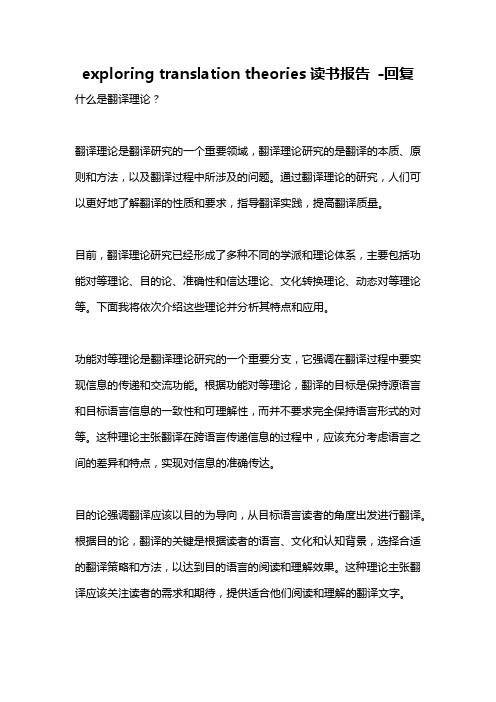
exploring translation theories读书报告-回复什么是翻译理论?翻译理论是翻译研究的一个重要领域,翻译理论研究的是翻译的本质、原则和方法,以及翻译过程中所涉及的问题。
通过翻译理论的研究,人们可以更好地了解翻译的性质和要求,指导翻译实践,提高翻译质量。
目前,翻译理论研究已经形成了多种不同的学派和理论体系,主要包括功能对等理论、目的论、准确性和信达理论、文化转换理论、动态对等理论等。
下面我将依次介绍这些理论并分析其特点和应用。
功能对等理论是翻译理论研究的一个重要分支,它强调在翻译过程中要实现信息的传递和交流功能。
根据功能对等理论,翻译的目标是保持源语言和目标语言信息的一致性和可理解性,而并不要求完全保持语言形式的对等。
这种理论主张翻译在跨语言传递信息的过程中,应该充分考虑语言之间的差异和特点,实现对信息的准确传达。
目的论强调翻译应该以目的为导向,从目标语言读者的角度出发进行翻译。
根据目的论,翻译的关键是根据读者的语言、文化和认知背景,选择合适的翻译策略和方法,以达到目的语言的阅读和理解效果。
这种理论主张翻译应该关注读者的需求和期待,提供适合他们阅读和理解的翻译文字。
准确性和信达理论认为翻译的目标是准确地传达原文的意思,并在目标语言中产生与原文意义相一致的效果。
根据准确性和信达理论,翻译的质量与原文的一致性、完整性和准确性密切相关,翻译应该尽可能地保持原文的信息和语气。
这种理论主张翻译在追求完美准确性的同时,也应该符合目标语言的特点和口感。
文化转换理论认为翻译是一种文化转换的过程,翻译不仅涉及语言的转换,更涉及到文化背景、价值观念和社会习俗等方面的转换。
根据文化转换理论,翻译应该尊重原文所处的文化环境,理解并传达原文所包含的文化内涵。
这种理论主张翻译应该避免文化冲撞和文化误解,促进不同文化之间的交流和理解。
动态对等理论认为翻译是一个动态的过程,翻译不能只关注原文和目标文本之间的对等关系,还需要考虑翻译过程中的动态变化和调整。
中西方翻译理论汇总
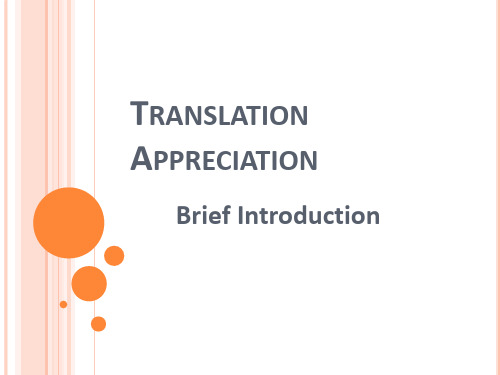
TRANSLATION THEORIES IN THE WEST
the ‘pre-linguistics period of translation’ triad: ‘literal’ faithful ‘free’
Translation Studies (since the second half of the 20th century) James S. Holmes (霍姆斯) Van Doorslaer (道斯莱尔)
诚心爱法,志愿益人,不殚久时,其备一也;
诚心热爱佛法,立志帮助别人,不怕费时长久。
·将践觉场,先牢戒足,不染讥恶,其备二也;
品行端正,忠实可信,不惹旁人讥疑。
·诠晓三藏,义贯两乘,不苦暗滞,其备三也;
博览经典,通达义旨,不存在暗昧疑难的问题。
·旁涉坟史,工缀典词,不过鲁拙,其备四也;
涉猎中国经史,兼擅文学,不要过于疏拙。
Contemporary: 严复:信、达、雅 傅雷:神似论 钱钟书:化境论 鲁迅:宁信而不顺--目的:引入英
文句式的表达法 梁实秋、赵景深:宁错务顺---目
的:可读性强,便于交流 瞿秋白:信顺统一 林语堂:忠实、通顺、美 许渊冲:优势竞赛论 辜正坤:多元互补论
所谓“五失本”,通俗地说就是,将原典翻译为汉语时, 有五种情况易于失去原本的面貌(不仅仅是“失去原意):(1) 胡语和汉语的语序或语言结构不同,翻译时要改变原文语序 采用汉语语序,因而译文失去了原典的语法结构特征。(2)原 典的语言本是质朴无华,而中国人一向喜好文饰,所以汉译 时会因修饰而失去原文语言质朴的特点。(3)原典常有反覆重 述的情形,翻译时容易被随意删削,会失去原典的文本特点。 (4)原典经文中,常附有解释说明性的文字,汉译时若被任意 删除,同样会失去原典的文本特征。(5)佛经有自己独特的语 体,它在说完一事再接叙它事之时,常有重述前文的情形, 汉译时多省略重覆的部分,所以会失去原文的语体特征。
翻译流派的划分(自己总结)
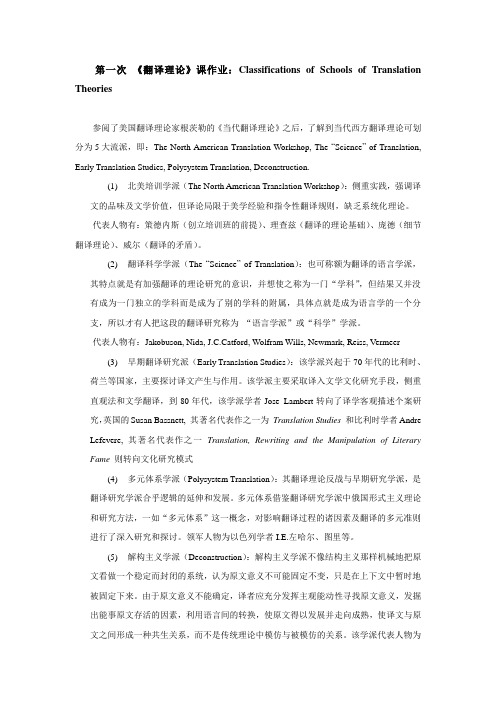
第一次《翻译理论》课作业:Classifications of Schools of Translation Theories参阅了美国翻译理论家根茨勒的《当代翻译理论》之后,了解到当代西方翻译理论可划分为5大流派,即:The North American Translation Workshop, The “Science” of Translation, Early Translation Studies, Polysystem Translation, Deconstruction.(1)北美培训学派(The North American Translation Workshop):侧重实践,强调译文的品味及文学价值,但译论局限于美学经验和指令性翻译规则,缺乏系统化理论。
代表人物有:策德内斯(创立培训班的前提)、理查兹(翻译的理论基础)、庞德(细节翻译理论)、威尔(翻译的矛盾)。
(2)翻译科学学派(The “Science”of Translation):也可称额为翻译的语言学派,其特点就是有加强翻译的理论研究的意识,并想使之称为一门“学科”,但结果又并没有成为一门独立的学科而是成为了别的学科的附属,具体点就是成为语言学的一个分支,所以才有人把这段的翻译研究称为“语言学派”或“科学”学派。
代表人物有:Jakobuson, Nida, J.C.Catford, Wolfram Wills, Newmark, Reiss, Vermeer(3)早期翻译研究派(Early Translation Studies):该学派兴起于70年代的比利时、荷兰等国家,主要探讨译文产生与作用。
该学派主要采取译入文学文化研究手段,侧重直观法和文学翻译,到80年代,该学派学者Jose Lambert转向了译学客观描述个案研究,英国的Susan Bassnett, 其著名代表作之一为Translation Studies 和比利时学者Andre Lefevere, 其著名代表作之一Translation, Rewriting and the Manipulation of Literary Fame则转向文化研究模式(4)多元体系学派(Polysystem Translation):其翻译理论反战与早期研究学派,是翻译研究学派合乎逻辑的延伸和发展。
中西方翻译理论汇总
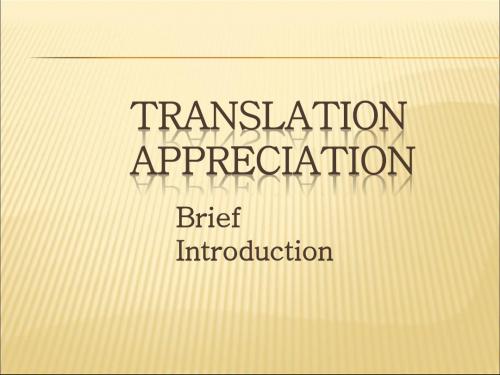
所谓“三不易”,即译经的时候有三种不容易的情况: (1)佛经是依当时的情况而说的,而今时俗全然不同,要 使经文变为今人可读可懂的文章,不容易。(2)千年以上的 圣贤所说的微言大义,要传达给百世以下的今世凡夫所理解, 不容易。(3)佛经是距佛世不久由大迦叶、阿难等具足神通 的大阿罗汉结集而成,现在要由千年后的凡夫俗子来传译,
TRANSLATION THEORIES IN THE WEST
the ‘pre-linguistics period of translation’ triad: ‘literal’ faithful ‘free’
Translation Studies (since the second half of the 20th century) James S. Holmes (霍姆斯) Van Doorslaer (道斯莱尔)
literary
linguisitc, within the text
cultural, beyond the text
Marcus Tullius Cicero (西塞罗)
The Roman rhetorician and politician (106–43 BCE )
And I did not translate them as an interpreter, but as an orator, keeping the same ideas and forms, or as one might say, the ‘figures’ of thought, but in language which conforms to our usage. And in so doing, I did not hold it necessary to render word for word, but I preserved the general style and force of the language. (Cicero 46 BCE /1960 CE : 364)
exploring translation theories读后感

在阅读"Exploring Translation Theories"这本书的过程中,我深感翻译理论的复杂性和多元性。
这本书的作者通过清晰简洁的文字,全面且详细地介绍了翻译理论的历史、现状以及各种不同的翻译理论。
首先,这本书让我对翻译理论有了更深入的理解。
从古代的直译、意译之争,到现代的功能翻译理论、生态翻译理论等,作者都进行了深入浅出的阐述。
尤其是对于各种翻译理论的产生和发展,作者都进行了详尽的历史背景分析,这不仅让我理解了翻译理论的来龙去脉,也让我对翻译理论的发展趋势有了更深入的认识。
其次,这本书拓宽了我的翻译理论视野。
在书中,作者不仅介绍了传统的翻译理论,还介绍了许多现代的翻译理论,如功能翻译理论、生态翻译理论等。
这些理论为我提供了新的视角和思考方式,让我在面对翻译问题时能够有更多的思考和选择。
最后,这本书也让我认识到翻译理论的实践意义。
通过对不同翻译理论的学习和理解,我能够更好地指导我的翻译实践。
同时,这本书也让我认识到翻译理论的发展是一个不断探索和创新的过程,只有通过不断的学习和实践,才能不断提高自己的翻译水平。
总的来说,"Exploring Translation Theories"是一本非常值得一读的书。
通过阅读这本书,我不仅对翻译理论有了更深入的理解,也拓宽了我的翻译理论视野。
同时,这本书也让我认识到翻译理论的实践意义,指导我在翻译实践中更好地应用各种翻译理论。
中西方翻译理论汇总
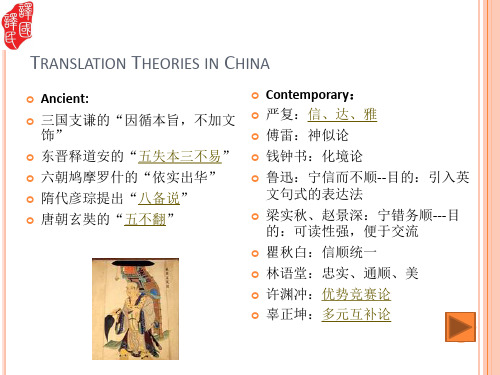
他引用孔子的“言之无文,行之不远”来 阐释“雅”的重要性。他认为不能用“近 世利俗文字”,“理之精者,不能载以粗 犷之词,而情之正者,不可达以鄙倍之气”
许渊冲:“美化之艺术、创优似竞赛” 乌夜啼 林花谢了春红,太匆匆! 无奈朝来寒雨晚来风。 胭脂泪,留人醉,几时重? 自是人生常恨水常东。 TUNE:“CROWS CRYING AT NIGHT” Spring’s rosy color fades from forest flowers Too soon,too soon. How can they bear cold morning showers And winds at noon? Your rouged tears like crimson rain Will keep me drink in woe. When shall we meet again? The stream of life with endless grief will
所谓“五不翻”,即五种不意译而是用音译的情形: 1、秘密故不翻。具有神秘色彩的词语应该不翻。如六字 真言“唵嘛呢叭咪吽”意为“哦!莲花里的珠宝”。不照 字面意义翻译出来,保持了佛语的神秘和庄重。 2、含多义故不翻。如梵语“薄伽梵”一词具有六种意义: “自在、炽盛、端严、名称、吉祥、尊贵”,这些词无法 找到等同的中文词. 3、无此故不翻。指源语所指代的事物在目的语文化中不 存在或是找不到对应物,如“阎浮树”。阎浮树只产于印 度等地, 在中国并无对应物,因此翻译时只能保留原音。 4、顺古故不翻。对于某些词语约定俗成的翻译方法,应 该不做更改。 5,生善故不翻。具有特殊意义或功能的词语也应该采用音 译, 因为有些词汇用音译能令人产生尊重之念,否则容 易让人忽视。例如梵文里“般若”的意思和智慧差不多, 如果我们把“般若”翻译成“智慧”就显得过于轻浅。
翻译流派的划分(自己总结)
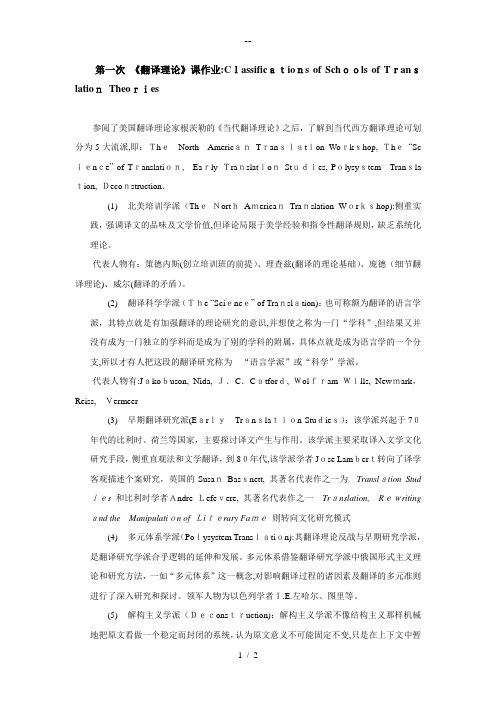
第一次《翻译理论》课作业:Classifications of Schools of TranslationTheories参阅了美国翻译理论家根茨勒的《当代翻译理论》之后,了解到当代西方翻译理论可划分为5大流派,即:TheNorth AmericanTranslation Workshop, The“Sc ience”of Translation,Early TranslationStudies, Polysystem Transla tion, Deconstruction.(1)北美培训学派(TheNorthAmericanTranslation Workshop):侧重实践,强调译文的品味及文学价值,但译论局限于美学经验和指令性翻译规则,缺乏系统化理论。
代表人物有:策德内斯(创立培训班的前提)、理查兹(翻译的理论基础)、庞德(细节翻译理论)、威尔(翻译的矛盾)。
(2)翻译科学学派(The “Science” of Translation):也可称额为翻译的语言学派,其特点就是有加强翻译的理论研究的意识,并想使之称为一门“学科”,但结果又并没有成为一门独立的学科而是成为了别的学科的附属,具体点就是成为语言学的一个分支,所以才有人把这段的翻译研究称为“语言学派”或“科学”学派。
代表人物有:Jakobuson, Nida, J.C.Catford, Wolfram Wills, Newmark,Reiss,Vermeer(3)早期翻译研究派(EarlyTranslation Studies):该学派兴起于70年代的比利时、荷兰等国家,主要探讨译文产生与作用。
该学派主要采取译入文学文化研究手段,侧重直观法和文学翻译,到80年代,该学派学者Jose Lambert转向了译学客观描述个案研究,英国的SusanBassnett, 其著名代表作之一为Translation Stud ies 和比利时学者Andre Lefevere, 其著名代表作之一Translation,Rewriting and the Manipulation of Literary Fame则转向文化研究模式(4)多元体系学派(Polysystem Translation):其翻译理论反战与早期研究学派,是翻译研究学派合乎逻辑的延伸和发展。
翻译理论—笔译

影响翻译得分的因素
• • • • A. 英、汉语基础不扎实造成理解错误。 B.缺乏相应的背景知识。 C.翻译表达速度过慢。(翻译速度慢) D.句法、措辞、拼写、标点等细节的错误。
翻译实践
原文: 在巴黎,名目繁多的酒会,冷餐会是广交朋 友的好机会。在这种场合陌生人相识,如果是亚 洲人,他们往往开口之前先毕恭毕敬地用双手把 自己的名片呈递给对方,这好像是不可缺少的礼 节。然而,法国人一般却都不大主动递送名片, 双方见面寒暄几句,甚至海阔天空地聊一番也就 各自走开,只有当双方谈话投机,希望继续交往 时,才会主动掏出名片。二话不说先递名片反倒 显得有些勉强。
Lecture 6
A Brief Introduction to Translation Theories (Principles)
Abroad and at Home
翻译实践
原文:
“赋”与“贼” • 过去有个人,识字不多,坐船外出做生意。 一天船停在“江心寺”,他就和同伴一起 下船到寺中闲逛。 • 寺院墙壁上写着“江心赋”三个字。他一 见,慌忙扭头就跑,喊道:“这里有江心 贼,不可久留!”他的同伴说:“不要慌, 这是‘赋’,不是‘贼’。”他摇头回答: “我看有些像‘贼’的样子。”
Assignments
Please do the E-C exercise of 1996 EMT 8 in your translation practice material. Please do the E-C exercise of 1997 EMT 8 in your translation practice material.
turned (round) around hurriedly (hastily/ in a haste/ in a rush) 参考译文: As soon as he saw these(characters/ words), he turned around hurriedly and began to run,…
翻译的语言学派
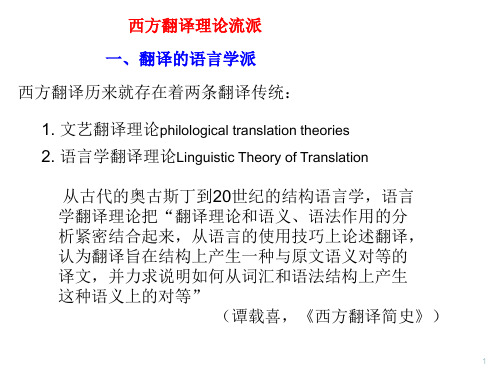
12
纽马克 (1916 ---):英国翻译理论家和翻译教育家。他提出 交际翻译、语义翻译和关联翻译。他的观点大多反映 在近二十年来发表的论文中。
4
欧洲任何其他语言学团体都没有像Prague学会 那样产生了如此巨大的影响。
Dwight Bollinger
Prague 学派曾影响到美国语言学的每一项重要 发了音位学(phonology)。
他们对语言的基本观点是:
1. 语言是一个价值系统,不是千千万万毫不相干 的孤立现象的汇合。因此,要分析语言成分 与其他成分的关系,考虑语言成分在交际中的 功能,这样才能更好理解和评价成分。
该学派把对语言所持的观点御用到翻译研究上。 他们对翻译的主要观点是:
6
1. 翻译必须考虑语言的各种功能,如认识功能、 表达功能、工具功能等;
2.翻译必须重视语义、语法、语音语言风格和文 学体裁方面的比较;
该翻译观在Prague学派的主要成员Jacobson和 后来的穆南、维内、马尔勃兰克、列维等重要 的翻译理论家的著作中都有不同程度的反映。
3. 准确的翻译取决于信息对等。
8
首次提出了翻译中的对等概念。 在语际翻译中,我们所关注的不仅是符号与符号 之间的对应(即逐词对应),而且也关注符号与 符号组合的对等。
翻译所涉及的是两种不同符号的对等信息,因此 他把翻译定义为:
用另一种语言的语符解释语言符号
他认为双语符号之间不存在完全对等的关系,对 等关系存在于符号所承载的信息,因此语际翻译 不是符号转换。而是信息转换。
3
有学者对翻译的语言学派做了起止时间的划分, 认为是从1959年Jacobson发表他的著名论文 《翻译的语言观》开始到1972年结束的。
西方翻译理论简介

• According to Steiner (1998: 248-9), the
history of discourse on translation is
divided into four periods:
• (1) a "traditional" period, from the
德莱顿(1631--1700)
• 翻译是艺术 • 翻译必须掌握原作特征 • 翻译必须考虑读者 • 译者必须绝对服从原作旳意思,在译文旳
措词上能够有自由,意义上却毫无自由。
• 翻译能够借用外来词 • 翻译分三类:逐字译、意译、拟作
2. German Romanticism
• At the beginning of the nineteenth century, a more
西塞罗主要观点
• 译者应该像演说家一样,使用符合古罗马
语言习惯旳语言来体现外来作品旳内容。
• 直译是缺乏技巧旳体现。翻译应保存词语
最内层旳东西,即意思。
• 翻译也是文学创作。 • 多种语言旳修辞手段彼此相通,所以翻译
能够做到风格对等。
• 提出“解释员”式翻译和“演说家”式翻译,即
直译与意译。
St. Jerome
• He insisted on “the accurate transmission of the meaning of the text rather than the budding orator's freely ranging imagination“.
• He introduced "the first major shift in western translation theory“.
翻译理论与实践TranslationtheoriesandPractice

翻译理论与实践(汉译英)Translation Theories and Practice (Chinese-English Translation )Teaching Notes for Senior College Students(2005年9月)刘国忠2578706*************.cnTopics at first:1. 解读汉译英《教学大纲》2. 解读汉译英《考试大纲》3. 汉译英学习指导①重要性②特性③实践性汉译英精典教材:1. 《英汉翻译教程》张培基喻天根《汉英翻译教程》吕瑞昌喻天根上海外语教育出版社 1980.92.《汉英翻译基础》陈宏薇上海外语教育出版社 1998/23.《英汉互译实用教程》宋天锡等国防工业出版社2000/14.《实用翻译教程》(英汉互译)增订本冯庆华上海外语教育出版社2002/55.《实用汉英翻译教程》曾诚外语教学与研究出版社2002/46.《翻译教学:实务与理论》刘宓庆中国对外翻译出版公司2003/1•汉译英主要内容:•一、汉译英实务教学•二、历届TEM8汉译英试卷评析•三、汉译英练习与评析•—汉英翻译强化训练汉译英实务教学主要内容一、汉英词语对比二、汉英句法基本差异(一)汉英句子的主语比较三、汉英句法基本差异(二)汉语谓语动词的分析和翻译四、被动语态的翻译五、汉译英中的主谓定位六、汉译英中的句子整合问题增补内容:七、如何避免翻译中的Chinglish八、汉英翻译中的文化传递九、公示语的翻译十、历届TEM8汉译英试卷评析十一、汉译英练习与评析—汉英翻译强化训练汉译英学习指导(一)如何保证翻译课的教学效果1.以―正当程序‖保证翻译质量无论英译汉,还是汉译英,译文都需要准确、通顺,这是翻译的基本要求。
表达准确的基础是对原文的准确理解:译者必须准确地理解原文的每个词、每句话和作者的意图。
表达通顺的基础是对译入语的熟练运用。
我们在做汉译英时,存在一个天然的劣势:由于英语不是我们的母语,做到表达的准确和通顺相当困难。
中外翻译理论
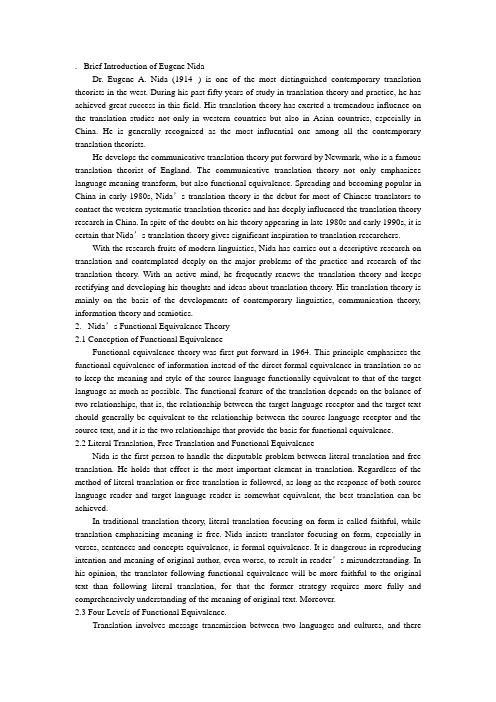
. Brief Introduction of Eugene NidaDr. Eugene A. Nida (1914--) is one of the most distinguished contemporary translation theorists in the west. During his past fifty years of study in translation theory and practice, he has achieved great success in this field. His translation theory has exerted a tremendous influence on the translation studies not only in western countries but also in Asian countries, especially in China. He is generally recognized as the most influential one among all the contemporary translation theorists.He develops the communicative translation theory put forward by Newmark, who is a famous translation theorist of England. The communicative translation theory not only emphasizes language meaning transform, but also functional equivalence. Spreading and becoming popular in China in early 1980s, Nida’s translation theory is the debut for most of Chinese translators to contact the western systematic translation theories and has deeply influenced the translation theory research in China. In spite of the doubts on his theory appearing in late 1980s and early 1990s, it is certain that Nida’s translation theory gives significant inspiration to translation researchers.With the research fruits of modern linguistics, Nida has carries out a descriptive research on translation and contemplated deeply on the major problems of the practice and research of the translation theory. With an active mind, he frequently renews the translation theory and keeps rectifying and developing his thoughts and ideas about translation theory. His translation theory is mainly on the basis of the developments of contemporary linguistics, communication theory, information theory and semiotics.2. Nida’s Functional Equivalence Theory2.1 Conception of Functional EquivalenceFunctional equivalence theory was first put forward in 1964. This principle emphasizes the functional equivalence of information instead of the direct formal equivalence in translation so as to keep the meaning and style of the source language functionally equivalent to that of the target language as much as possible. The functional feature of the translation depends on the balance of two relationships, that is, the relationship between the target language receptor and the target text should generally be equivalent to the relationship between the source language receptor and the source text, and it is the two relationships that provide the basis for functional equivalence.2.2 Literal Translation, Free Translation and Functional EquivalenceNida is the first person to handle the disputable problem between literal translation and free translation. He holds that effect is the most important element in translation. Regardless of the method of literal translation or free translation is followed, as long as the response of both source language reader and target language reader is somewhat equivalent, the best translation can be achieved.In traditional translation theory, literal translation focusing on form is called faithful, while translation emphasizing meaning is free. Nida insists translator focusing on form, especially in verses, sentences and concepts equivalence, is formal equivalence. It is dangerous in reproducing intention and meaning of original author, even worse, to result in reader’s misunderstanding. In his opinion, the translator following functional equivalence will be more faithful to the original text than following literal translation, for that the former strategy requires more fully and comprehensively understanding of the meaning of original text. Moreover.2.3 Four Levels of Functional Equivalence.Translation involves message transmission between two languages and cultures, and therestill exists lots of similarity among different language cultures, which is the objective basis. Because of the different location, history, cultural ground and education level, it is hard to be objective. The definition of translation Nida proposed shows that translation is not only related to equivalence of lexical meaning, but also the equivalence of text connotation and style, message translated in translation includes surface lexical message and deep cultural message. Functional equivalence includes four levels: lexical equivalence, sentence equivalence, passage equivalence and style equivalence.2.3.1 Lexical equivalenceThe meaning of a word lies in its usage in language. In translation practice, what confuse us is how to find the corresponding meaning in target language. Take Tension is building up as an example, tension and build up both have different explanations without consideration of context. Thus this sentence can be translated as several different editions:In English—Chinese translation, completely lexical equivalence lies in special terms and terminology, besides which there are five correspondences, word equivalence, synonymy, polysemy, lexical meaning overlap and zero equivalence.2.3.2 Sentence EquivalenceSentence equivalence is more complicated than lexical equivalence. In English- Chinese translation, singular and plural form is an important and evident problem. Plural meaning in Chinese is not expressed with any evident plural form, which is different in English. Moreover, for different target language, tender, number and tense should be taken into consideration in translation. Thus, translator should be clear about whether such a sentence grammar exists in the target language or not, and be clear about the frequency of such sentence grammar.2.3.3 Passage EquivalenceIn order to achieve passage equivalence, language is not the unique element we should consider, what we should also take into consideration is how the language represents meaning and performs its function in a specific context. Passage equivalence consists of three parts, passage context, scene context and cultural context. Passage context lies in analysis of language, which aims to judge the meaning of words and semantic units in original text, and is based on analysis of meaning and connotation of the passage. Scene context includes the concrete person and things involved in communication, the channel of communication, the relationship among participants and mental emotions.3. ConclusionNida’s translation theory has been popular in the world for nearly sixty years and it has become an indispensable part of translation studies. Holding a panoramic view of all the important points in Nida’s theory, we can conclude that the essence of his theory is that he insists the translator should pay prior attention to the meaning of the source text and should not be curbed by the expression form of the source text. Moreover, Nida’s translation theory is a genuine breakthrough and its influence and contribution to the translation field cannot be underestimated, and it dose render us a profound enlightenment that the excellent translation comes from practice.Nida has been a pioneer in the fields of translation theory and linguistics.His Ph.D. dissertation, A Synopsis of English Syntax, was the first full-scale analysis of a major language according to the "immediate-constituent" theory. His most notable contribution to translation theory is Dynamic Equivalence, also known as Functional Equivalence. For more information, see "Dynamic and formal equivalence." Nida also developed the"componential-analysis" technique, which split words into their components to help determine equivalence in translation (e.g. "bachelor" = male + unmarried). This is, perhaps, not the best example of the technique, though it is the most well-known.Nida's dynamic-equivalence theory is often held in opposition to the views of philologists who maintain that an understanding of the source text(ST) can be achieved by assessing theinter-animation of words on the page, and that meaning is self-contained within the text (i.e. much more focused on achieving semantic equivalence).This theory, along with other theories of correspondence in translating, are elaborated in his essay Principles of Correspondence,[6]where Nida begins by asserting that given that “no two languages are identical, either in the meanings given to corresponding symbols or in the ways in which symbols are arranged in phrases and sentences, it stands to reason that there can be no absolute correspondence between languages. Hence, there can be no fully exact translations.”[7] While the impact of a translation may be close to the original, there can be no identity in detail.Nida then sets forth the differences in translation, as he would account for it, within three basic factors: (1) The nature of the message: in some messages the content is of primary consideration, and in others the form must be given a higher priority. (2) The purpose of the author and of the translator: to give information on both form and content; to aim at full intelligibility of the reader so he/she may understand the full implications of the message; for imperative purposes that aim at not just understanding the translation but also at ensuring no misunderstanding of the translation. (3) The type of audience: prospective audiences differ both in decoding ability and in potential interest.Nida brings in the reminder that while there are no such things as “identical equivalents” in translating, what one must in translating seek to do is find the “closest natural equivalent”. Here he identifies two basic orientations in translating based on two different types of equivalence: Formal Equivalence (F-E) and Dynamic Equivalence (D-E).F-E focuses attention on the message itself, in both form and content. Such translations then would be concerned with such correspondences as poetry to poetry, sentence to sentence, and concept to concept. Such a formal orientation that typifies this type of structural equivalence is called a “gloss translation” in which the translator aims at reproducing as literally and meaningfully as possible the form and content of the original.The principles governing an F-E translation would then be: reproduction of grammatical units; consistency in word usage; and meanings in terms of the source context.D-E on the other hand aims at complete “naturalness” of expression. A D-E translation is directed primarily towards equivalence of response rather than equivalence of form. The relationship between the target language receptor and message should be substantially the same as that which existed between the original (source language) receptors and the message.The principles governing a D-E translation then would be: conformance of a translation to the receptor language and culture as a whole; and the translation must be in accordance with the语言学派翻译理论奥古斯丁发展了亚里士多德的“符号”理论,提出了语言符号的“能指”、“所指”和译者“判断”的三角关系,开创了西方翻译理论的语言学传统。
History-of-translation-theory-翻译简史
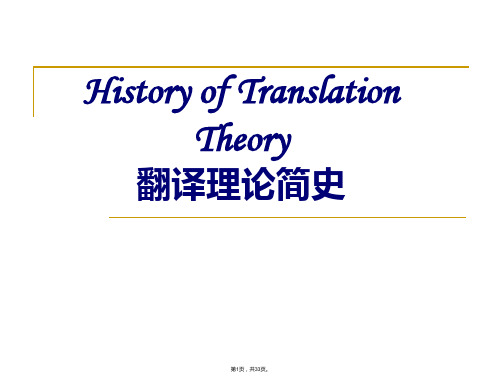
(一)西方翻译实践史
第五次翻译高潮为文艺复兴后,从十七世纪 下半叶至十二世纪上半叶,西方各国的翻译 继续向前发展。虽然就其规模和影响而言, 这一时期的翻译比不上文艺复兴时期,但仍 然涌现出大量的优秀译著。其最大特点是, 翻译家们不仅继续翻译古典著作,而且对近 代的和当代的作品也发生了很大的兴趣。塞 万提斯、莎士比亚、巴尔扎克、歌德等大文 豪的作品都被一再议成各国文字,东方文学 的译品也陆续问世。
文艺复兴时期,(荷兰)伊拉斯谟的不屈从神 学权威、《圣经》的翻译靠译者的语言知识; (德国)路德的翻译必须采用民众语言的人文 主义观点;(法国)多雷的译者必须理解原作 内容、通晓良种语言、避免逐字对译、采用通 俗形式、讲究译作风格的“翻译五原则”。
第11页,共33页。
(二)西方翻译理论发展史
在十七至十九世纪,(法国)巴托的“作者是主人”(译者是 仆人)、译文必须“不增不减不改”的准确翻译理论;(英国) 德莱顿的“直译”、“意译”、“拟作”的翻译三分法和翻译 是艺术的观点;(英国)泰特勒的优秀译作的标准和“译作应 完全复写出原作的思想、译作的风格和手法应和原作属于同一 性质、译作应具备原作所具有的通顺”等翻译三原则; (德国) 施莱尔马赫的口译与笔译、文学翻译与机械性翻译的区分; (德国)洪堡的语言决定世界观和可译性与不可译性的理论; (英国)阿诺德的“翻译荷马必须正确把握住荷马特征”的观 点。
第三次翻译高潮出现在中世纪中期,即十一至十二世纪 之间,在西班牙的托莱多,把阿拉伯语翻译成拉丁语。早 在九世纪和十世纪,叙利亚学者就来到雅典,把大批希腊 典籍译成古叙利亚语,带回巴格达。在巴格达,阿拉伯人 又把这些著作译成阿拉伯语,巴格达一时成为阿拉伯人研 究古希腊文化的中心。后来,在托莱多译成拉丁语的许多 希腊典籍便是从这些阿拉伯文译本转译的。于是,托莱多 成为欧洲的学术中心(类似与巴格达的"翻译院"),翻译 及学术活动延续达百余年之久发展史
Introduction to the Course of Translation Theories and Practice

Introduction to the Course of Translation Theories and PracticeQuestions for discussion1. What is translation?2. How many categories do you think translation can be divided into, and what are they?3. What are the characteristics of translation? Describe it in detail, please.4. What is style and stylistics? What is the relationship between style and translation?5. What are we going to learn in this course?6. What is translation theory and what are translation techniques? What is the relationship between them?7. As a translator, what competence should you have? Can you describe it in detail?8. How can we learn the course well?·Translation is as old as a language itself , probably starting from thousands years ago . It has been used as an indispensable means of mediation , a useful aid to preaching and teaching , and to the social and culture , and commercial exchanges and mutual understanding between different peoples and different countries . It has become part of human life.Definitions of translation1) Translation consists in reproducing in the receptor language the closest natural equivalent of the source language, first in terms of meaning and secondly in terms of style.所谓翻译,是在译语中用最切近的自然的对等语再现原语的信息,首先是意义,其次是文体.2) The replacement of textual material in one language (SL) by equivalent textual material in another language (TL).翻译可作如下界定:用一种语言(目的语)的文本材料对等地再现另一种语言(出发语)的文本材料.3) A translation should give a complete transcript of the ideas of the original work. The style and manner of writing should be of the same character as that of the original. A translation should have all the ease of the original composition.Definitions of translation译文应完全复写出原作的思想。
翻译有哪些理论

翻译有哪些理论翻译学中的理论有很多,以下是其中的一些主要理论:1.等效理论(Equivalence Theory):由Eugene Nida和Charles Taber于1960年提出。
该理论认为翻译的目标是在不同语言之间传达与源文本相等或相似的意义。
它强调翻译的等级和程度,分为准确传递(充分等效)、部分传递(偏远等效)和恢复信息(零等效)。
2.功能对等理论(Functional Equivalence Theory):由Christiane Nord于1991年提出。
该理论认为翻译的目标是根据目标语言和文化的读者需求,在功能上等效于源文本。
它强调翻译的目的是满足读者对论述、表述和信息的期望,并做出相应调整。
3.文化翻译理论(Cultural Translation Theory):由AndréLefevere于1992年提出。
该理论认为翻译是一种文化间的传递和变革过程,强调翻译的文化因素对于意义的建构和解读至关重要。
它探讨了源文本和目标文本之间的文化差异,并提出了译者作为文化中介者的角色。
4.再现理论(Relevance Theory):由Dan Sperber和Deirdre Wilson于1986年提出。
该理论认为翻译的目标是传递有效沟通所需的信息,并尽可能减少读者的认知努力。
它强调翻译要遵循言语交际原则,提供最相关和最明确的信息,以确保双方的理解和交流。
5.干扰理论(Interference Theory):源于歧义和误会的语言干扰现象。
干扰理论认为翻译是在源语言和目标语言之间进行的,源语言结构和表达方式会对译文产生不同程度的影响。
干扰理论研究译者如何解决干扰问题,以确保翻译的准确性和流畅性。
6.社会文化理论(Sociocultural Theory):由Lev Vygotsky于20世纪初提出。
社会文化理论认为翻译是一种社会和文化实践,翻译活动受到社会环境和文化背景的影响。
它研究翻译与社会和文化因素之间的相互关系,强调译者的角色和社会文化认知对翻译的重要性。
- 1、下载文档前请自行甄别文档内容的完整性,平台不提供额外的编辑、内容补充、找答案等附加服务。
- 2、"仅部分预览"的文档,不可在线预览部分如存在完整性等问题,可反馈申请退款(可完整预览的文档不适用该条件!)。
- 3、如文档侵犯您的权益,请联系客服反馈,我们会尽快为您处理(人工客服工作时间:9:00-18:30)。
Eugene Nida
Rome, UniversitàLa Sapienza, 2004
(with me and Dr. Hirci)
Elena Zagar Galvã o - ITS 07 FLUP
4
What name to give to the new, budding discipline?
psycho-translation studies)
Elena Zagar Galvã o - ITS 07 FLUP
13
The results of DTS research can then be applied to Tth to develop:
• a general theory of translation (very ambitious) • partial theories restricted according to:
Elena Zagar Galvã o - ITS 07 FLUP 11
The Holmes Map of Translation Studies (2)
Holmes’ categories were simple, scientifically framed, and hierarchically arranged: ‘Applied’ was opposed to ‘Pure’, the latter was broken down into ‘Theoretical’ and ‘Descriptive’, then ‘Descriptive’ divided in turn into ‘Product Oriented’, ‘Process Oriented’ and ‘Function Oriented’, and so on. Figure 1 (previous slide) shows the apocryphal graphic form these categories received later from, I believe, Gideon Toury, who saw it as a legitimate point of departure (it is also in Toury 1995: 10). Many wonderful things found a place in this map; a few more have benefited from the modifications and variants proposed since (notably Lambert 1991, Snell-Hornby 1991, Toury 1991, Toury 1995). Of course, translation studies cannot be reduced to this one map, and the map itself has been evolving dynamically, along with the lands it purports to represent.
from: Intercultural Studies Group, Universitat Rovira i Virgili, Tarragona, Spain http://isg.urv.es/library/papers/holmes_map.doc
Elena Zagar Galvã o - ITS 07 FLUP
Elena Zagar Galvã o - ITS 07 FLUP 2
• 1950s and 1960s: more systematic, scientific (mainly linguistic) approach to T: e.g., Vinay and Darbelnet (1958), George Mounin (1963); Nida (1964); Catford (1965); EUGENE NIDA Toward a Science of Translating, 1964
12
DESCRIPTIVE TS
DTS focuses on 3 areas of research:
PRODUCT (synchronic; diachronic) FUNCTION (translation sociology or
socio-translation studies)
PROCESS (psychology of translation or
Elena Zagar Galvã o - ITS 07 FLUP
10
The Holmes Map of Translation Studies (1)
James S Holmes’ seminal ‘The Name and Nature of Translation Studies’ (1972) set out to orient the scholarly study of translation. It put forward a conceptual scheme that identified and interrelated many of the things that can be done in translation studies, envisaging an entire future discipline and effectively stimulating work aimed at establishing that discipline. Historically, this was a major step forward, none the least because it involved a frontal attack on the hazy but self-assured categories that had long been used to judge translations.
Elena Zagar Galvã o - ITS 07 FLUP
7
Holmes concludes that :
• the most appropriate name for the discipline in English is TRANSLATION STUDIES (TS), for this term would avoid a lot of “confusion and misunderstanding”; • There should be communication channels able to reach all scholars in the field, from whatever background; • TS can be divided into 2 main research areas: „PURE‟
WHAT IS TRANSLATION STUDIES?
ITS – Power Point 5
10 October 2007
Elena Zagar Galvã o - ITS 07 FLUP 1
Brief historical overview
• TRANSLATION as an academic subject is only about 50 years old. • Before: T was mainly used for language teaching (thus secondary status in academia) • 1960s-1970s: communicative approach in TEFL • 1960s-1970s: translation workshop (USA); comparative literature; contrastive analysis
Elena Zagar Galvã o - ITS 07 FLUP 6
• “[Holmes] realized as did few others that the 1950s had heralded a revolution in translation studies” (van den Broeck, 1988,1994:3) • Holmes highlighted the existence of 3 main impediments to the further development of the discipline: - scholars and researchers scattered in different fields and therefore lack of common channels of communication; - “the seemingly trivial matter of the name for this field of research”; van den Broeck, 1988,1994:68) - “lack of any general consensus as to the scope and structure of the discipline” (ibid.:71)
„APPLIED‟
Elena Zagar Galvã o - ITS 07 FLUP
8
Pure TS has 2 main goals (descriptive and theoretical): 1. “to describe the phenomena of translating and translation(s) as they manifest themselves in the world of experience” (Descriptive Translation Studies, DTS) 2. “to establish general principles by means of which these phenomena can be explained and predicted.” (Translation Theory, TTh)
